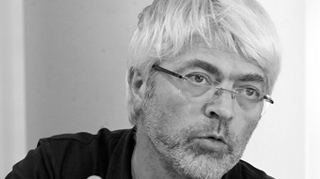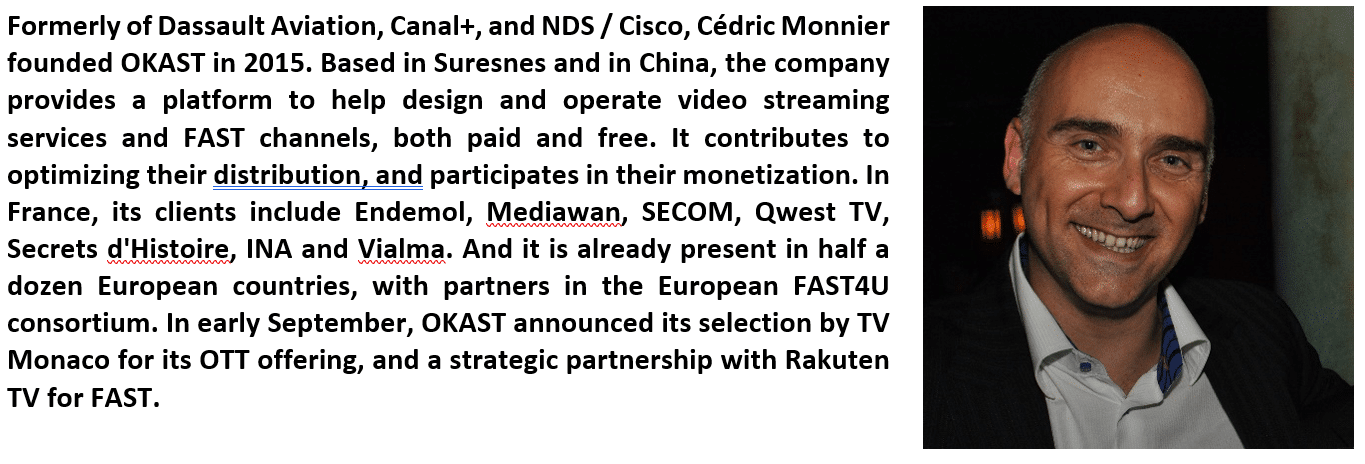On the eve of IBC, you have just announced two agreements, one with Rakuten TV and the other with Monaco TV. What are the key takeaways?
Cédric Monnier: The creation of a national channel is a rare event. We’re even prouder to have been chosen by TV Monaco to operate all its OTT developments. For us, it’s recognition of the expertise we’ve acquired in creating streaming services, whether linear or on-demand, and whether paid or free. This know-how extends to our ability to accompany publishers on all digital platforms, and this is where the strategic agreement we’ve just signed with Rakuten TV comes into play: it adds to the deals we already have with Samsung TV Plus, Pluto TV, Roku, LG Channels, Plex, TCL, Xiaomi, Huawei, and many others, to ensure the widest possible distribution for our customers’ channels, in France and the four other main European markets, as well as in North America and Brazil. We’re right in line with the objectives of the European FAST4EU consortium that we’ve been leading since spring 2022 with SECOM and Kinostar.
“Free streaming represents CTV’s main driver!“
So you’re right in the middle of the CTV wave! But with so many different acronyms, it’s easy to lose sight of the meaning and dynamics…
Cédric Monnier: It’s true that even professionals get confused… and with the acronyms multiplying – AVoD, BVoD, FAST, HVoD, SVoD, VoD, VoL – there’s a lot to get used to! But for the public, the acronyms don’t really matter, and can be summed up in three points:
- Time spent watching video continues to increase, reaching 5 hours 30 minutes in Spain, for example.
- The ability to juggle from one screen to another to reach the famous ATAWAD
- But a big premium on the TV set, which accounts for around 80% of time spent everywhere.
And since more than half of all TV sets are now smart TVs, viewers are increasingly free to navigate between the various OTT platforms. This first fueled the development of SVoD. Audiovisual group apps like MyTF1, ITVX or the new Atresplayer, FAST and AVoD platforms like Samsung TV Plus, Pluto TV or Rakuten TV, and of course YouTube, are now taking over. Today, free streaming is CTV’s main driver.
“FAST channel editors are going to have to raise their game!“
Is this the death of the operator box?
Cédric Monnier: Let’s not bury them too quickly, especially not in France, where triple play will celebrate its 20th anniversary at the end of the year. And even in the United States, described as the most successful case of cord cutting, to say that one American in two has “cut the cord” means, conversely, that one in two remains loyal to the operators…
So we also need to be able to adapt our customers’ channels to telco environments. This is the aim of our partnership with Broadpeak, which enables us to integrate them into the bouquets of several French and European operators. This ability to combine the OTT world and managed networks is becoming increasingly essential, when we see, for example, that Virgin Media has just added a large section of FAST channels to its service plan in the UK. We’re talking about over 3.5 million subscriber households!
“Adapting in real time to the specificities of the FAST environment”.
In interviews conducted for the AVoD Market Report, some publishers lamented the fact that audiences for their channels were not growing faster. Is it really all a question of distribution?
Cédric Monnier: Of course not. In your study, you mention the imminent arrival of major DTT players such as Altice, France Télévisions and ARTE on certain platforms. For free streaming as a whole, this will be a tremendous boost to usage. But for publishers who are already on Samsung TV Plus, Pluto TV or Rakuten TV, it also represents a challenge: to ride this wave, they’ll have to raise their game, so they’ll have to be even more vigilant about the quality of the content they broadcast, the rate at which it’s refreshed, the optimization of their programming and the enhancement of their advertising inventory.
And on this point, we help our customers to better integrate the specificities of the FAST environment: a peak audience that changes from one channel to another with, on average, a 30-minute time lag compared to traditional television, tracking of the “online life cycle” of programs to know when to renew them, optimized duration of commercial breaks to avoid zapping… Because we constantly monitor the channels we operate, we can make these adjustments in real time.
Another source of frustration for publishers is the level of revenues actually collected. With the feeling that there are a lot of guests for a cake that is still modest: 15 M€ in sales in France in 2022, according to our estimates.
Cédric Monnier: An easy answer would be to refer you to the more than $4 billion in revenues in 2022 in the United States, the more than €150 million in Great Britain and almost as much in Germany… But it’s not enough to see that the grass is growing in the meadow next door!
Two comments then.
On costs, first of all, the best way to improve a P&L is to control expenses and, for example, in the case of FAST, to pay close attention to distribution costs (CDN costs) and advertising insertion costs. We are very vigilant about this with our customers, who can benefit from the conditions we can obtain from service providers thanks to our market surface.
The other point is the optimization of advertising insertion conditions. And on this point too, free-to-air streaming doesn’t play by the same rules as DTT or cabsat theme channels. Working on advertising scheduling is key.
Media agencies also point to the lack of data available to estimate and qualify audiences…
Cédric Monnier: Here again, the realities are not the same, depending on whether you’re in France or on the other side of the Atlantic. In the U.S., Nielsen is already able to say that Pluto TV, Roku and Tubi already account for nearly 3.5% of total time spent on TV. This confirms that the potential of free streaming is no fiction! In Europe, the integration of FAST into usage measurement is slower. Médiamétrie suggests the start of 2025 for France…
But we’re not going to sit back and wait for this deadline. Together with our partners in the FAST4U consortium, we are about to launch a large-scale survey of viewers in the main European countries. This will give us a better idea of how many of them watch FAST channels. It will give us information on their profiles. And beyond that, it will give us a better idea of what else they watch – TV, SVoD, YouTube on the TV set… – to help advertisers deduplicate audiences. See you at next year’s MIPCOM for the first results!



